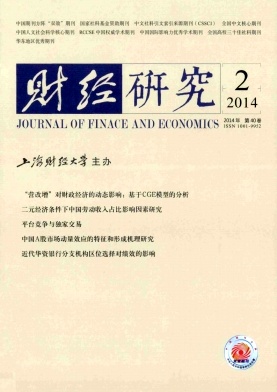跨越“中等收入陷阱”:理论、经验和对策——基于44个国家的跨国实证分析
财经研究 2014 年 第 40 卷第 02 期, 页码:54 - 66
摘要
参考文献
摘要
文章以经典的经济增长理论为理论基础,分别考察了跌入"中等收入陷阱"的典型国家和跨越"中等收入陷阱"的典型国家,采用固定效应、一阶差分GMM和系统GMM计量方法,对影响经济增长的因素做了分析。文章的研究发现,通货膨胀、政府支出和高抚养比对"陷阱"国家的经济增长有明显的负面影响,而技术进步对"陷阱"国家的经济增长缺乏显著性。对跨越"陷阱"国家而言,投资、消费、技术对其经济增长呈现明显的拉动作用。我国人均GDP在进入上中等收入阶段后,在结构变迁过程中要及时转变经济发展方式,通过扩大消费、增加投资、促进技术进步来实现经济的稳定持续增长,同时要通过改革来避免过度城镇化,抑制通货膨胀,为我国经济增长创造一个稳定的外部环境,以使我国顺利跨越"中等收入陷阱"。
[1]蔡昉.“中等收入陷阱”的理论、经验与针对性[J].经济学动态,2011,(12):4-9.
[2]蔡昉.中国经济增长如何转向全要素生产率驱动型[J].中国社会科学,2013,(1):56-71.
[3]蔡昉.理解中国经济发展的过去、现在和将来——基于一个贯通的增长理论框架[J].经济研究,2013,(11):4
[4]邸玉娜,李月.跨越“中等收入陷阱”的国际经验分析——基于出口产品密度的视角[J].经济科学,2012,(4):35-48.
[5]林毅夫.新结构经济学与中国发展之路[J].中国市场,2012,(50):3-8.
[6]倪国华,郑风田.通货膨胀与“中等收入陷阱”:家庭福利损失的视角[J].经济理论与经济管理,2012,(3):36-47.
[7]伍业君,张其仔.比较优势演化与经济增长——基于阿根廷的实证分析[J].中国工业经济,2012,(2):37-46.
[8]郑秉文.“中等收入陷阱”与中国发展道路——基于国际经验教训的视角[J].中国人口科学,2011,(11);2-15.
[9]中国经济增长与宏观稳定课题组.中国可持续增长的机制:证据、理论和政策[J].经济研究,2008,(10):13-25.
[10]Bloom D,Williamson J.Demographic transitions and economic miracles in emerging Asia[J].World Bank Economic Review,1998,12(3):419-455.
[11]Bloom D,Canning D.Global demographic change:Dimensions and economic significance.[R].NBER Working Paper No.10817,2004.
[12]Bloom D,Canning D,Malaney P.Demographic change and economic growth in Asia[J].Population and Development Review,2000(26):257-290.
[13]Buchanan J,Tullock G.The calculus of consent:Logical foundations of constitutional democracy[M].Ann Arbor:University of Michigan Press,1962.
[14]Bussière M,Fratzscher M.Financial openness and growth:Short-run gain,long-run pain?[J].Review of International Economics,2008,16(1):69-95.
[15]Calderon C,Serven L.The effects of infrastructure development on growth and income distribution[R].Central Bank of Chile Working Paper No.270,2004.
[16]DeLong J,Shleifer A.Princes and merchants:European city growth before the industrial revolution[J].Journal of Law and Economics,1993,36(2):671-702.
[17]Demetriades P,Mamuneas T.Intertemporal output and employment effects of public infrastructure capital:Evidence from 12OECD economics[J].Economic Journal,2000,110(465):687-712.
[18]Egert B,Kozluk T,Sutherland D.Infrastructure and growth:Empirical evidence[R].CESifo Working Paper No.2700,2009.
[19]Eichengreen B,Park D,Shin K.When fast growing economies slow down:International evidence and implications for China[R].NBER Working Paper No.16919,2011.
[20]Eichengreen B,Park D,Shin K.Growth slowdowns redux:New evidence on the middle-income trap[R].NBER Working Paper No.18673,2013.
[21]Harris J,Todaro M.Migration,unemployment and development:A two-sector analysis[J].American Economic Review,1970,60(1):126-142.
[22]Hausmann,R,Pritchett L,Rodrik D.Growth accelerations[J].Journal of Economic Growth,2005,10(4):303-329.
[23]Higgins M.Demography,national savings,and international capital flows[J].International Economic Review,1998,39(2):343-369.
[24]Kelley A,Schmidt S.Saving,dependency and development[J].Journal of Population Economics,1996,9(4):365-386.
[25]Knack S,Keefer P.Does social capital have an economic payoff?A cross-country investigation[J].Quarterly Journal of Economics,1997,112(4):1251-1288.
[26]La Porta R,Lopez-de-Silanes F,Shleifer A,et al.Legal determinants of external finance[J].Journal of Finance,1997,52(3):1131-1150.
[27]La Porta R,Lopez-de-Silanes F,Shleifer A,et al.Law and finance[J].Journal of Political Economy,1998,106(6):1113-1155.
[28]Aoki M.The five-phases of economic development and institutional evolution in China and Japan[R].ADBI Working Paper No.340,2011.
[29]Mason A.Population change and economic development in East Asia:Challenges met,opportunities seized[M].CA:Stanford University Press,2001.
[30]Mauro P.Corruption and growth[J].Quarterly Journal of Economics,1995,110(3):681-712.
[31]North D.Structure and change in economic history[M].New York:Norton&Company,1981.
[32]North D.Institutions,institutional change and economic performance[M].Cambridge:Cambridge University Press,1990.
[33]Roller L,Waverman L.Telecommunications infrastructure and economic development:A simultaneous approach[J].American Economic Review,2001,91(4):909-923.
[34]Shekhar A,Romain D,Damien P,et al.Growth slowdowns and the middle-income trap[R].IMF Working Paper No.13/71,2013.
①根据世界银行2011年最新分类标准,人均国民收入低于1 025美元的属于低收入国家,在1 026-4 035美元之间的,属于下中等收入国家,在4 036-12 475美元的属于上中等收入国家,超过12 476美元的属于高收入国家。若按此标准,目前世界上有36个经济体处于低收入阶段,有54个经济体位于下中等收入阶段,有54个经济体处于上中等收入阶段,有70个经济体处于高收入阶段,其中有31个经济体属于OECD国家或地区。
[2]蔡昉.中国经济增长如何转向全要素生产率驱动型[J].中国社会科学,2013,(1):56-71.
[3]蔡昉.理解中国经济发展的过去、现在和将来——基于一个贯通的增长理论框架[J].经济研究,2013,(11):4
[4]邸玉娜,李月.跨越“中等收入陷阱”的国际经验分析——基于出口产品密度的视角[J].经济科学,2012,(4):35-48.
[5]林毅夫.新结构经济学与中国发展之路[J].中国市场,2012,(50):3-8.
[6]倪国华,郑风田.通货膨胀与“中等收入陷阱”:家庭福利损失的视角[J].经济理论与经济管理,2012,(3):36-47.
[7]伍业君,张其仔.比较优势演化与经济增长——基于阿根廷的实证分析[J].中国工业经济,2012,(2):37-46.
[8]郑秉文.“中等收入陷阱”与中国发展道路——基于国际经验教训的视角[J].中国人口科学,2011,(11);2-15.
[9]中国经济增长与宏观稳定课题组.中国可持续增长的机制:证据、理论和政策[J].经济研究,2008,(10):13-25.
[10]Bloom D,Williamson J.Demographic transitions and economic miracles in emerging Asia[J].World Bank Economic Review,1998,12(3):419-455.
[11]Bloom D,Canning D.Global demographic change:Dimensions and economic significance.[R].NBER Working Paper No.10817,2004.
[12]Bloom D,Canning D,Malaney P.Demographic change and economic growth in Asia[J].Population and Development Review,2000(26):257-290.
[13]Buchanan J,Tullock G.The calculus of consent:Logical foundations of constitutional democracy[M].Ann Arbor:University of Michigan Press,1962.
[14]Bussière M,Fratzscher M.Financial openness and growth:Short-run gain,long-run pain?[J].Review of International Economics,2008,16(1):69-95.
[15]Calderon C,Serven L.The effects of infrastructure development on growth and income distribution[R].Central Bank of Chile Working Paper No.270,2004.
[16]DeLong J,Shleifer A.Princes and merchants:European city growth before the industrial revolution[J].Journal of Law and Economics,1993,36(2):671-702.
[17]Demetriades P,Mamuneas T.Intertemporal output and employment effects of public infrastructure capital:Evidence from 12OECD economics[J].Economic Journal,2000,110(465):687-712.
[18]Egert B,Kozluk T,Sutherland D.Infrastructure and growth:Empirical evidence[R].CESifo Working Paper No.2700,2009.
[19]Eichengreen B,Park D,Shin K.When fast growing economies slow down:International evidence and implications for China[R].NBER Working Paper No.16919,2011.
[20]Eichengreen B,Park D,Shin K.Growth slowdowns redux:New evidence on the middle-income trap[R].NBER Working Paper No.18673,2013.
[21]Harris J,Todaro M.Migration,unemployment and development:A two-sector analysis[J].American Economic Review,1970,60(1):126-142.
[22]Hausmann,R,Pritchett L,Rodrik D.Growth accelerations[J].Journal of Economic Growth,2005,10(4):303-329.
[23]Higgins M.Demography,national savings,and international capital flows[J].International Economic Review,1998,39(2):343-369.
[24]Kelley A,Schmidt S.Saving,dependency and development[J].Journal of Population Economics,1996,9(4):365-386.
[25]Knack S,Keefer P.Does social capital have an economic payoff?A cross-country investigation[J].Quarterly Journal of Economics,1997,112(4):1251-1288.
[26]La Porta R,Lopez-de-Silanes F,Shleifer A,et al.Legal determinants of external finance[J].Journal of Finance,1997,52(3):1131-1150.
[27]La Porta R,Lopez-de-Silanes F,Shleifer A,et al.Law and finance[J].Journal of Political Economy,1998,106(6):1113-1155.
[28]Aoki M.The five-phases of economic development and institutional evolution in China and Japan[R].ADBI Working Paper No.340,2011.
[29]Mason A.Population change and economic development in East Asia:Challenges met,opportunities seized[M].CA:Stanford University Press,2001.
[30]Mauro P.Corruption and growth[J].Quarterly Journal of Economics,1995,110(3):681-712.
[31]North D.Structure and change in economic history[M].New York:Norton&Company,1981.
[32]North D.Institutions,institutional change and economic performance[M].Cambridge:Cambridge University Press,1990.
[33]Roller L,Waverman L.Telecommunications infrastructure and economic development:A simultaneous approach[J].American Economic Review,2001,91(4):909-923.
[34]Shekhar A,Romain D,Damien P,et al.Growth slowdowns and the middle-income trap[R].IMF Working Paper No.13/71,2013.
①根据世界银行2011年最新分类标准,人均国民收入低于1 025美元的属于低收入国家,在1 026-4 035美元之间的,属于下中等收入国家,在4 036-12 475美元的属于上中等收入国家,超过12 476美元的属于高收入国家。若按此标准,目前世界上有36个经济体处于低收入阶段,有54个经济体位于下中等收入阶段,有54个经济体处于上中等收入阶段,有70个经济体处于高收入阶段,其中有31个经济体属于OECD国家或地区。
引用本文
代法涛. 跨越“中等收入陷阱”:理论、经验和对策——基于44个国家的跨国实证分析[J]. 财经研究, 2014, 40(2): 54–66.
导出参考文献,格式为:
下一篇:平台竞争与独家交易
本期封面
相关论文





 8570
8570  4467
4467

